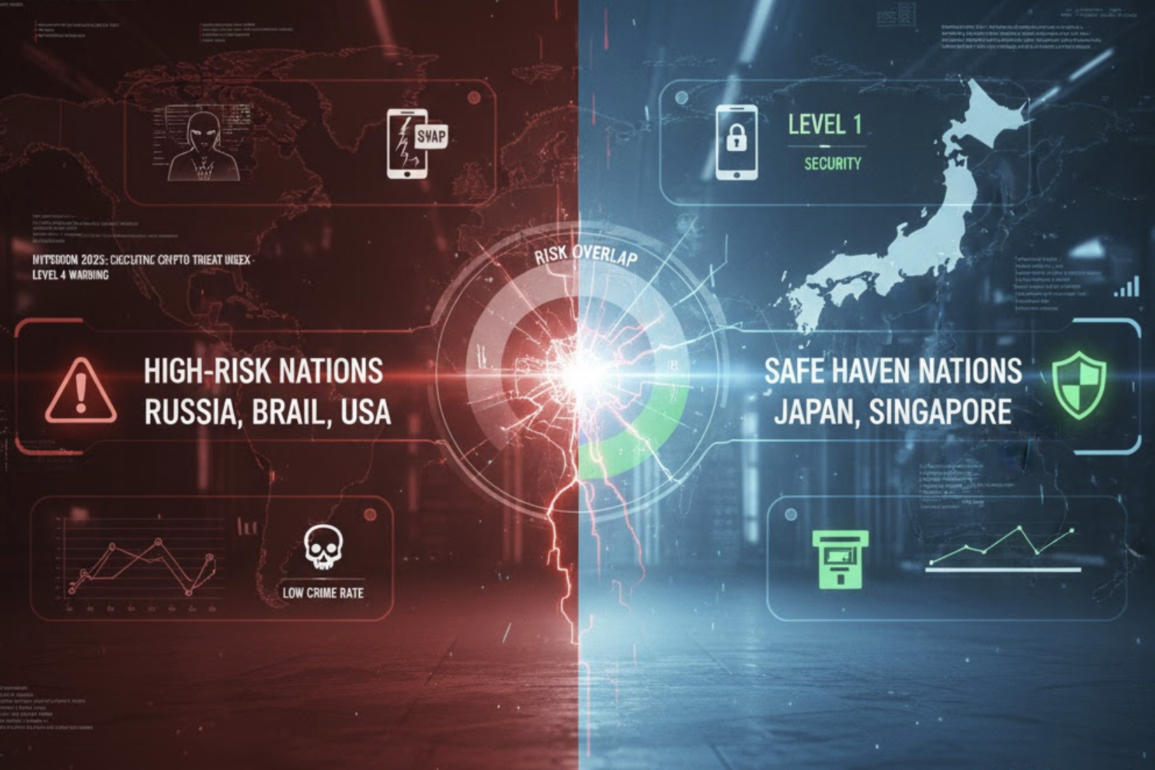After the arrest of Chinese businessman Zhimin Qian and one of the largest cryptocurrency seizures in history, new research from cybersecurity firm Hyperion has mapped a growing threat to the global crypto elite.
The firm’s Executive Crypto Threat Index (ECTI) ranks 15 nations according to the dangers faced by high-value cryptocurrency investors, combining four dimensions of risk — cybercrime, physical safety, telecommunications vulnerability, and Bitcoin ATM exposure — into a single score.
According to the 2025 index, Brazil and Russia are among the most perilous environments for wealthy crypto holders, followed closely by the United States. At the other end of the spectrum, Japan and Singapore are considered among the safest, thanks to strict SIM-card registration laws, low crime rates, and limited ATM exposure.
“For the first time, we can see how cyber, physical, and telecom threats overlap for crypto wealth,” Adam Gonzales, chief executive of Hyperion told Afcacia. “The ECTI highlights why wealthy crypto executives must be as concerned with personal safety as they are with portfolio security.”
Russia tops the list, combining severe cyber and physical threats. With homicide rates of 8.2 per 100,000 and a Level 4 travel advisory from the U.S. State Department, the country’s environment is among the world’s most hazardous.
It also features prominently in Chainalysis reports as a hub for ransomware operations and illicit crypto flows, compounding the danger for investors. Despite its relatively small number of Bitcoin ATMs — around 26 nationwide — Hyperion notes that the convergence of violent crime and entrenched cybercrime ecosystems makes Russia the riskiest country for crypto executives.
The United States ranks second, largely due to its enormous visibility and exposure. With more than 31,000 Bitcoin ATMs, it has the highest count globally, paired with record-setting cybercrime losses.
The FBI’s Internet Crime Complaint Center (IC3) reported $9.3 billion in crypto-related losses in 2024, including 982 SIM-swap complaints resulting in nearly $26 million in damages. Although the U.S. homicide rate, 6.8 per 100,000, remains lower than Brazil’s or Russia’s, its scale of exposure and cybercrime volume propel it into the top tier of global risk.
Brazil comes third, driven primarily by extreme physical insecurity. Its homicide rate of 25 per 100,000 — the highest among major economies — dwarfs global averages. While Bitcoin ATMs remain rare, with only about 90 nationwide, the combination of violence, extortion, and kidnapping risks makes personal safety the key concern for crypto investors.
The U.S. State Department officially lists Brazil as a Level 2 travel risk, but Hyperion’s analysts argue that “this understates the real threats faced by wealthy crypto holders.”
The report also highlights telecommunications vulnerabilities as an emerging front in crypto security. The United Kingdom, which recorded a staggering 1,055 percent increase in SIM-swap fraud, now ranks among the top ten countries for overall exposure.
In contrast, Japan and Singapore’s low homicide rates, mandatory SIM-card registration, and minimal ATM networks place them near the bottom of the risk spectrum.
Gonzales said the findings suggest that as crypto wealth becomes more visible, traditional crime and digital threats are converging. “The ECTI shows that wealth in crypto is no longer a purely digital risk,” he said. “It’s a human one, too.”
The methodology behind the index integrates data from Chainalysis, the United Nations Office on Drugs and Crime, and multiple national cybersecurity agencies. Cyber threats account for 35 percent of a country’s score, while physical risk weighs 40 percent. Telecommunications risk and ATM exposure make up the remaining 25 percent combined.
While the index is designed to help companies assess geopolitical risk in crypto markets, it also underscores a broader question — how governments can protect citizens whose assets exist outside the banking system.
As crypto holdings blur the boundary between finance and physical safety, Hyperion’s findings reveal an uncomfortable truth: in the age of decentralized wealth, even digital assets are not immune to real-world danger.




